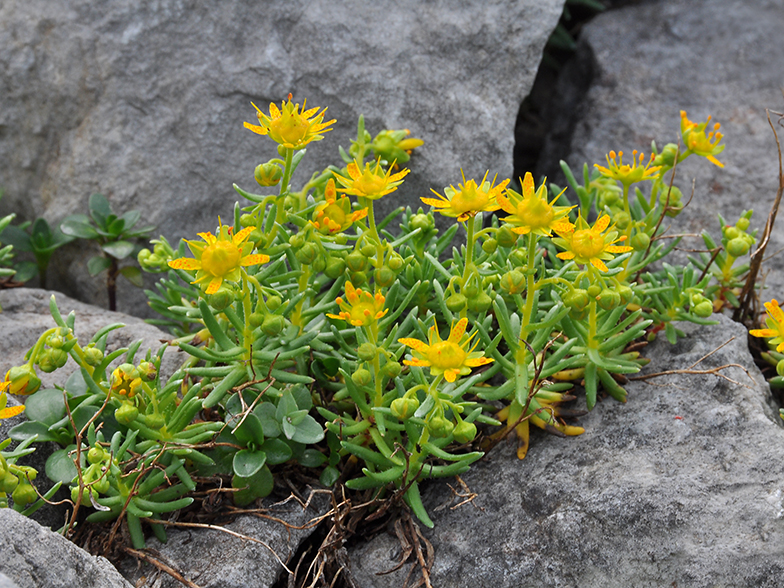Saxifraga aizoides
Fettenhennen - saxifrage ( Saxifraga aizoides )
The sedum - saxifrage ( Saxifraga aizoides ) is a plant of the genus Saxifrage ( Saxifraga ). He is also known as Bach - saxifrage or source - saxifrage, featuring his preference for a wet location. More rarely, this type is also called as ciliated saxifrage. The Artepipheton aizoides (Greek = always alive ) refers to the evergreen leaves.
Description
The sedum - saxifrage is a richly branched, grassy growing, perennial plant, reaching heights of growth of about 5 to 20 centimeters. It has loose leafy, glandular hairy stem. The usually dark green, often red crowded leaves are 10 to 25 mm long and are quite meaty ( sedum ). In the vegetative state, the type resembles the species of stonecrop (Sedum ). The leaf margin is ciliated, at the blade tip is a bright patch cartilage tip to detect.
In a glandular- hairy, loose, racemose inflorescence, two to twelve flowers hermaphrodite flowers The combined have a diameter of about 15 mm. The petals are yellow to dark orange, rarely they are also dark red, with darker points. The flowering period extends from June to September. The flowers of sedum - Streinbrechs be visited next Diptera by ants.
The seeds remain three weeks buoyant and thus explain the frequent descent of rivers far below the actual distribution area.
The species has 2n = 26 chromosome number
Occurrence
The distribution area includes the arctic and subarctic Canada with southern foothills on the west and east coasts to the U.S. border. Greenland, eastern Iceland, Svalbard, Novaya Zemlya, the Polar Urals and the Arctic NO Russia with the Kola Peninsula, Scandinavia and the Alps from the Pyrenees to the Balkans.
He is also in the Northern Ireland and the UK ( south to Yorkshire ) spread.
The Fettenhennen Saxifrage preferred source corridors but also debris ( moraines ) and rock (wet) at an altitude 600-3100 meters. In the Arctic, it is also common in the relatively dry tundra. He rises with the rivers far into the foothills down (about to Munich with the Isar ). In northern Europe, it grows well at sea level.
Historical
Among the names Sedula montana pulchra this type was already known in 1563 the botanist Valerius Cordus. Linnaeus took this typical arctic - alpine plant in Lapland and gave it its current name.
Others
In Lower Austria and Tyrol, the locals call the Fettenhennen saxifrage also " Gamswurz ", like many other plants that are eaten by chamois. In some tracts of land Tyrol is also the name of " herb warts " is used because it has been used to remove warts.
Pollen were detected by scientists in late-glacial sediments in Denmark, the Netherlands and some German low mountain ranges.
The Fettenhennen Saxifrage applies in the northern foothills of the Alps as endangered.









